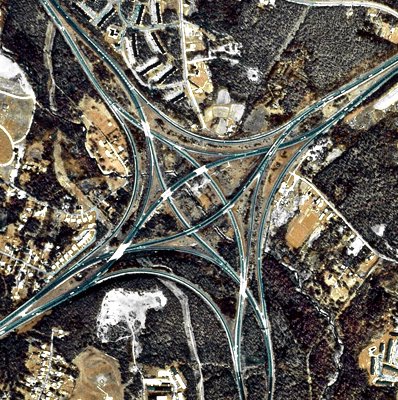 [Image: The self-weaving complexity of I-95 and I-695, north of Baltimore].
[Image: The self-weaving complexity of I-95 and I-695, north of Baltimore].
For a variety of reasons, it seems worthwhile to do a kind of combined recap of my recent talks for the AIA in Baltimore and at the University of Pennsylvania. If you were present at either one of those events, then this should hopefully serve as a nice trip down memory lane; if you weren’t there, this should give at least some idea of the topics covered, themes discussed, images seen, and so on. Of course, if this sounds even remotely interesting, I’d be more than happy to give a similar talk at a venue near you… I’ve been having a blast doing these things.
In any case, I was in Baltimore two weeks ago on a joint invitation from the AIA and Preservation Maryland, to discuss architectural preservation, broadly conceived, with at least some relation to Baltimore proper.
So I began my lecture with a story from the science journals back in fall 2005. It turns out, we learned, that a specific highway junction north of Baltimore – where I-95 and I-695 meet – is topologically unique, exhibiting something called “non-trivial braiding.” However, because of that structure’s inefficiency as a traffic conveyor, the merging on- and off-ramps were going to be rebuilt, reconnected, and otherwise altered beyond mathematical recognition.
Its topology, in other words, would be ruined.
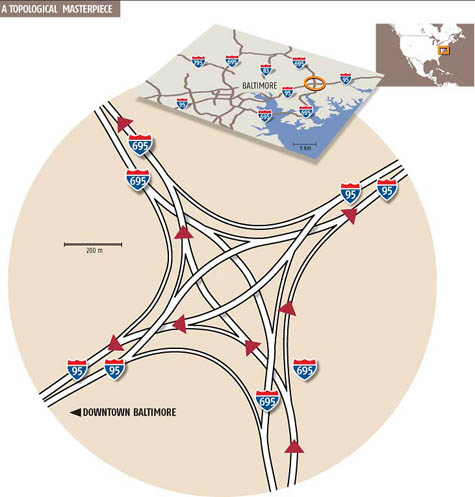 [Image: A diagram of the “non-trivial braiding” that awaits you on the eastern seaboard; via New Scientist].
[Image: A diagram of the “non-trivial braiding” that awaits you on the eastern seaboard; via New Scientist].
A little bit of roadwork, and that mathematical object would be gone.
“I don’t want to encourage more cars onto the roads,” New Scientist wrote, “but if topology and beauty mean anything to you, get out there and enjoy I-95/695 now. It may soon be too late.”
So the question becomes: at what point do we preserve something not for its historical value but for its topological interest? If a bridge, or a highway overpass, becomes functionally obsolete, is it still subject to the rules of architectural preservation – whether or not it’s mathematically unique or culturally intriguing? Surely infrastructure is just infrastructure – i.e. when it breaks you replace it? You don’t preserve infrastructure.
Or do you?
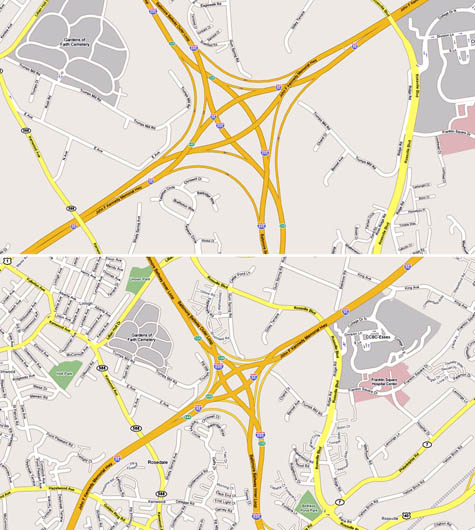 [Images: Google Maps of the famed intersection].
[Images: Google Maps of the famed intersection].
Meanwhile, at what point does the exchange value of culture and history trump the use value of function and design?
And should mathematicians have any say?
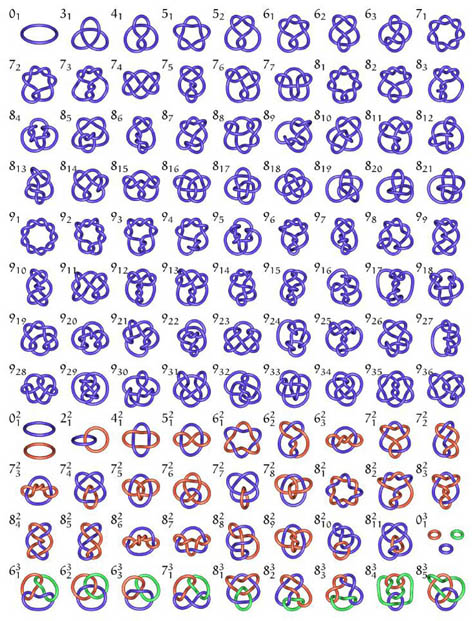 [Image: Knot diagrams by Robert Scharein. Could we treat these as infrastructural blueprints and redesign the U.S. highway system to form a catalog of complex knots? You could then study experiential mathematics from behind the wheel of your car…].
[Image: Knot diagrams by Robert Scharein. Could we treat these as infrastructural blueprints and redesign the U.S. highway system to form a catalog of complex knots? You could then study experiential mathematics from behind the wheel of your car…].
Perhaps there’s a middle ground here. Perhaps we can, in fact, preserve something like a highway traffic exchange without forcing people to use its outdated twists and turns.
This brings us to the idea of the stabilized ruin.
If we could remove the intersection, for instance, from everyday use and simply build around it, we could then stabilize it as a ruin – turning it into a kind of abstract sculptural form, like something by Barbara Hepworth – and, at the very least, create an interesting site for mathematically inclined tourists.
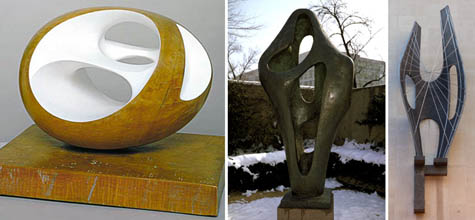 [Images: Three sculptures by Barbara Hepworth – build these big enough and they’d be pieces of urban infrastructure].
[Images: Three sculptures by Barbara Hepworth – build these big enough and they’d be pieces of urban infrastructure].
For visual reference here I mentioned architect Alberto Campo Baeza‘s 2002 proposal for a Mercedes Benz Museum. Might Campo Baeza’s structure be a model for what the I-95/695 intersection would look like if it was detached from the highway system and left alone, to be surrounded by new freeways?
It’d be a kind of modern-day Stonehenge, made from on-ramps, surrounded by wildflowers, with well-designed signs to explain its fine geometry. Loops of concrete in space.
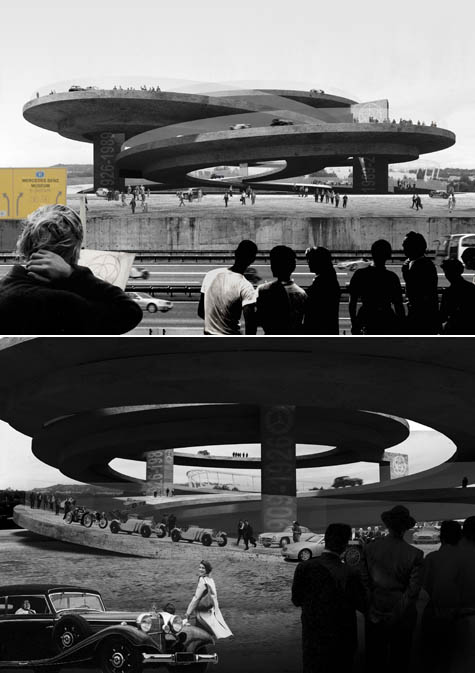 [Images: Proposal for a Mercedes Benz Museum by Alberto Campo Baeza].
[Images: Proposal for a Mercedes Benz Museum by Alberto Campo Baeza].
Of course, there are other stabilized ruins – and here, trying to keep things regional, I pointed out Philadelphia’s Eastern State Penitentiary, highlighting photographs taken there by Shaun O’Boyle. We see some examples of O’Boyle’s work here in this post – and O’Boyle, of course, was featured in BLDGBLOG’s earlier look at Bannerman’s Island.
“After 142 years of consecutive use,” the penitentiary’s website explains, “Eastern State Penitentiary was completely abandoned in 1971, and now stands, a lost world of crumbling cell blocks and empty guard towers.” It was one of the only two U.S. sites that Charles Dickens went out of his way to visit, on a trip in 1842; the other was Niagara Falls.
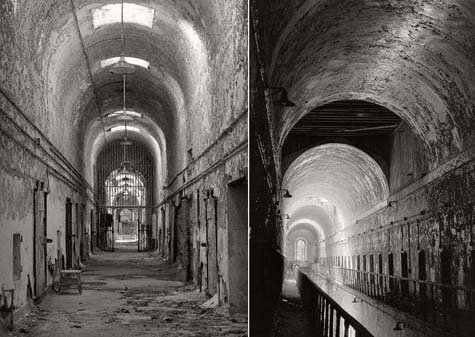
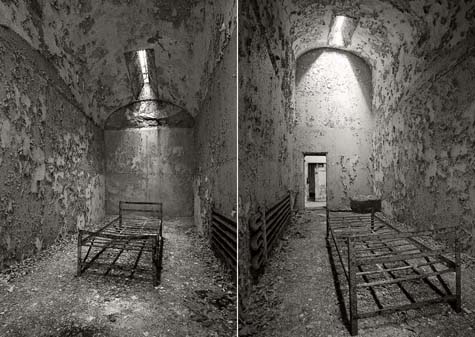 [Images: Four photos of Eastern State Penitentiary, taken by Shaun O’Boyle].
[Images: Four photos of Eastern State Penitentiary, taken by Shaun O’Boyle].
So if stabilization is a viable preservation strategy, then what are its limits? What is too small to worry about – and what is too large even to consider?
Back in the late 1990s, photographer and urban sociologist Camilo José Vergara controversially proposed that a “skyscraper ruins park” be built in downtown Detroit. In his book American Ruins, Vergara suggested that, “as a tonic for our imagination, as a call for renewal, as a place within our national memory, a dozen city blocks of pre-Depression skyscrapers be stabilized and left standing as ruins: an American Acropolis.”
Continuing this line of thought in a later article for Metropolis, Vergara wrote:
We could transform the nearly 100 troubled building into a grand national historic park of play and wonder, an urban Monument Valley… Midwestern prairie would be allowed to invade from the north. Trees, vines, and wildflowers would grow on roofs and out of windows; goats and wild animals – squirrels, possum, bats, owls, ravens, snakes and insects – would live in the empty behemoths, adding their call, hoots and screeches to the smell of rotten leaves and animal droppings.
Of course, fantasies of ruined cities are alive and well, so to speak. One need only look as far as the disastrous film I Am Legend, or turn to Alan Wiseman’s recent bestseller The World Without Us to see that the appeal of dead cities never quite fades.
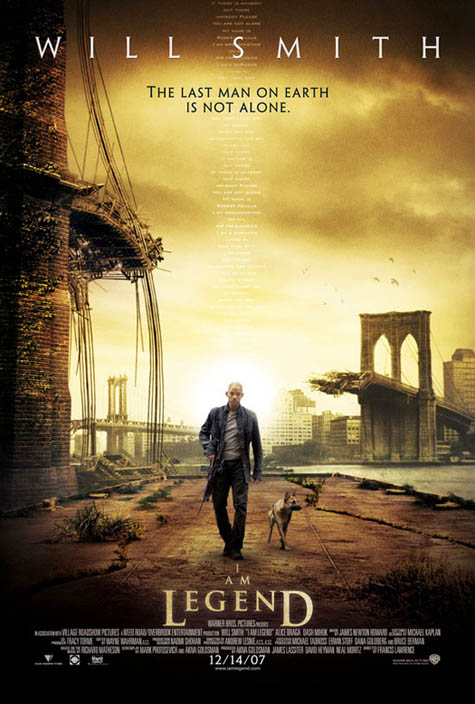 [Image: A poster for I Am Legend].
[Image: A poster for I Am Legend].
Indeed, I’m tempted here to pitch a new breed of entertainment complex to some oil-rich emir or investment group: the idea is that you would build a ruined city on the shores of an artificial island somewhere south of all the luxury developments in Dubai, and you’d invite tourists to explore those haunted canyons of steel and broken glass.
For the low-low price of only $75,000 a day, you can rent the entire park for yourself – and thus be Will Smith for a day, wandering through ruined department stores and sunbathing in weed-filled plazas.
At the very least, imagine the political implications of such a park: touring the ruins of the west by visiting Dubai – where the shattered remnants of Euro-America are nothing but a theme park for global tourists.
With recognizable buildings from London, New York, Chicago, Paris, Rome, and so on, I suppose it’d be a little like the film Resident Evil: Extinction, where we see the lost lights of Las Vegas buried in desert sand.
Only here it’s a simulacrum of the entire western world, and it’s laid out as waste at the feet of Dubai’s glass towers and air-conditioned boulevards.
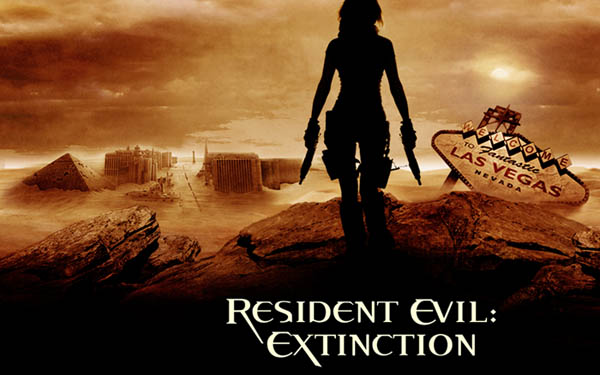 [Image: A poster for Resident Evil: Extinction].
[Image: A poster for Resident Evil: Extinction].
In any case, with accidentally good timing, we moved on from there into a discussion of architect Albert Speer’s notorious plans for the Nazi super-city of Germania: a vision of what Berlin would become, given the presumed global triumph of Hitler and his skeletal empire. Of course, Speer’s by now well-known architectural theory was that all buildings should be designed so that they will look good in the future as ruins.
He called this ruin value.
I say “good timing” here, because Germania is actually the focus of a well-publicized exhibition in Berlin, going on right now, called Myth Germania. It comes complete with a detailed model of Speer’s urban vision – bits of which can be seen here in old photographs.
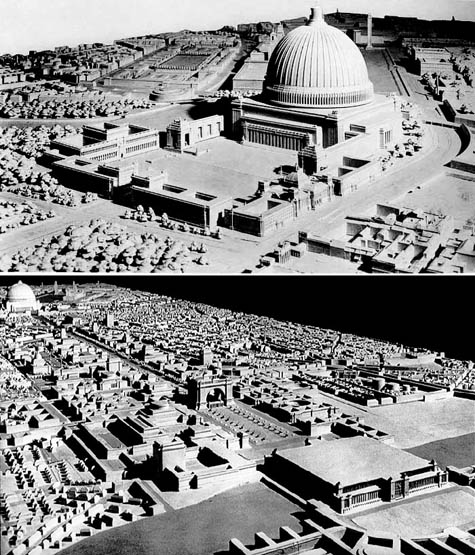 [Images: Albert Speer’s Germania].
[Images: Albert Speer’s Germania].
Although ruined cities appear again and again here on BLDGBLOG – and will continue to do so – there is a stage beyond ruin, something that comes after dereliction and abandonment. As long as we are willing to think along geological timescales, in other words, then we can talk about what I’ve called urban fossil value.
What will our cities look like when they have fossilized?
Who else but New Scientist approached this very topic nearly a decade ago, explaining that, hundreds of millions of years from now, many of our cities will indeed become fossils.
These fossil cities will be “a lot more robust than [fossils] of the dinosaurs,” geologists Jan Zalasiewicz and Kim Freedman wrote, and those fossils will consist of “the abandoned foundations, subways, roads, and pipelines of our ever more extensive urban stratum” – becoming “future trace fossils” of a lost form of life.
The already subterranean undersides of our modern cities, from Tube tunnels to secret government bunkers, “will be hard to obliterate. They will be altered, to be sure, and it is fascinating to speculate about what will happen to our very own addition to nature’s store of rocks and minerals, given a hundred million years, a little heat, some pressure (the weight of a kilometer or two of overlying sediment) and the catalytic, corrosive effect of the underground fluids in which all of these structures will be bathed.”
Plastics, for instance, “might behave like some of the long-chain organic molecules in fossil plant twigs and branches, or the collagen in the fossilized skeletons of some marine invertebrates.” A hundred thousand Evian bottles, then, might someday be transformed by compression into a new quartz: vast and subterranean veins of mineralized plastic.
Of course, all of this depends on the future tectonic fates of certain regions. Los Angeles, for instance, “is on an upward trajectory,” the geologists explain, “pushed by pressure from the adjacent San Andreas Fault system,” and so it is “doomed to be eroded away entirely.” But if a city is flooded, buried in sand, or otherwise absorbed downward, then “the stage is set to produce ideal pickling jars for cities. The urban strata of Amsterdam, New Orleans, Cairo and Venice could be buried wholesale – providing, that is, they can get over one more hurdle: the destructive power of the sea.”
 [Images: Fossils, via the Fossil Museum].
[Images: Fossils, via the Fossil Museum].
Rather than talk about ruin value, then, which is so Romantically 18th century, why not strive for fossil value instead? Tens of millions of years in the future, when all of this urban infrastructure has turned to sludge, and radiative terrestrial heat has cooked old bricks into something resembling trace fossils, our cities could still be beautiful.
Can we design for this fate? Can we plan urban fossils ahead of time?
Can we give our constructions urban fossil value?
turning it into a kind of abstract sculptural form
Last summer I redesigned most of the Highway Interchanges in Los Angeles and in many ways created them to look like an abstract sculptural form, specifically, an arabesque.
Anyways, in this dystopian future of yours, I’d mine the highways for concrete, bricks, and miscellaneous building materials (solar panels are going first!). No need to go into the earth when building materials are on the surface just waiting to be used.
Great post and interesting question! Preserving infastructure is interesting to me because in a lot of older cities the infstructure acts like an exposed skeleton. For exmaple, in Philadelphia, functionality trups aesthetic form. The Schukyl Expressway and rail lines runs right next ro the Schukyl River which is prime real estate. But do these critical pieces of infastructure which will eventually be replaced sometime in the future need to be preserved?
I don’t know but it is an interesting question.
I’ve wondered about architectural fossils before, but the other way around: how can we design so that the structure holds well enough for as long as we would occupy it (its lifetime), and then let it recycle itself back into the environment. Something along the lines of an organic structure.
ps: loving this blog 🙂
Good point, LK. Is there any way to create the ANTI-urban fossil? To leave no trace of our built existence? To design structures that fulfill their intended use and “disappear”?
Further extending that idea, is there any way to be a species that leaves no trace (at all) of our existence? I know it would be virtually impossible with everything we’ve done to the earth thus far. But if that’s the case, then maybe this has happened already in the earth’s history. Maybe there was a species implementing the same kind of ideas that I’m proposing, and we know nothing (and will never know anything) about them because they have left NOTHING behind… Interesting stuff to think about.
On another note (to the author), I absolutely love your writings and ideas. I’ve been reading your blog for a while now, and every time I see a new post I truly get excited! So thank you!
It’s interesting to think that in Alberto Campo Baeza’s proposal when we literally sever infrastructure’s relationship to context we are left with a haunting ruinous fragment which resembles a spaceship that has just landed.
The architect John Soane knew the spatial possibilities of taking a fragment and juxtaposing it in new ways, similar to Albert Speer’s vision of a mythologized Nazi empire. In Soane’s design for the Bank of England, J.M. Gandy renders the building in a scene of future ruin, cast in the prophecy of destruction by fire. He anticipates and embeds the image of ruin within the built work (and there are more haunting mysteries in the building which anticipate destruction by fire such as the Tivoli Corner, the Arch of Constantine, the Pantheon, which are all fragments of the building that deal with fire, domesticity, the hearth. and new beginnings–the ancient roman tale of the vestal virgins anointing the birth of a new city by the flame of the original roman city). As it happens, the Great Fire of London did occur, rendering the Bank of England in it’s presupposed ruinous state as a case for anti-sustainability…
Similarly Le Corbusier, in his plan Voisin anticipated the aerial bombardment of Paris by clearing the ground plane and evacuating the population into a series of vertical towers. Drawn in the time after WWI and in the period leading up to WWII, it is a haunting, if drastic image of disaster.
Great Blog!
It makes me wonder if there is a way to design for decay? And I suppose prior to this the question would be why would you want to the building to decay?
As in, is it possible to control the rates of decay (what decays first, last) or set benchmarks which the building can begin to be disused?
Check this out:
http://www.terraswarm.com/projects/vegas.html
Maybe you’ve seen this before…
site
This post reminded me of Hubert Robert’s pair of images from 1796 (see link), imagining the Louvre 1)as a re-organized museum space and 2)in ruins. Raises the issue for me of the specifically p-o-l-i-t-i-c-a-l ramifications of this question. How will architectural fossils come to be? Who will be left behind, abandoned by history in this way, and why? Even thinking out loud that the course of american empire will run aground is something I can’t even imagine one of the current presidential candidates doing, even if it is happening now before our very eyes.
Thanks for the links and comments!
And I actually covered the 10 Mile Spiral a while back – I love that project: 10 Mile Spiral.
Thanks for the thoughts .
The topologically-interesting I-95/I-695 interchange received public attention in Fall ’05 because of the column “Cartographiana” that I wrote, appearing in The Mathematical Intelligencer 27 #2 (Spring 2005). There’s a PDF available on my old publications page.
–Michael Kleber
Nuks, maintaining an infrastructure that leaves no trace…
native american indians?
a tragic irony if ever…
cool post Geoff!
will the value of the ruins be measured on the same scale as ours?
Let’s not virtual ruins -so many computer game worlds revel in the ruin as form of entertainment, the twists and turns of a ruin for ruins sake. Ruin as playground.
In David Bruin “Uplift” SciFi series, entire planets are used, left to fallow and then reused as civilizations come and go. To make sure that traces of the former occupants disappear, apparently most cities are built near the edge of subducting plate. Left fallow for a few millions of years, even the most solid structures disappear.
The Baltimore knot wouldn’t even need to be abandoned to stay preserved; I could easily imagine the roadways being turned into elevated parkland and pedestrian community space. Similarly, I could imagine that old prison being turned over to one of the monastic religions for conversion to a monastery or convent; as I recall, it was designed with monastic ideas in mind for reforming criminals.
I am reminded of Giffin and Termeer’s stunning tiles based upon satellite images of interchanges. Check out: http://www.giffintermeer.com/
They describe the project as:
“INTERCHANGE TILES, 2004
Patterns for these ceramic tiles were drawn directly from satellite imagery of large highway interchanges from around the world. Interchanges which are expensive public works projects have a complex beauty equal to the buildings and public sites usually remembered with souvenirs.”
I posted about those a few summers ago, actually: interchange tiles.
Maybe with a bit of delay… There are cities/villages built for decay – not as an intention but as an effect. In the valley of the Atlas, in Marroco, where construction is made out of mud/clay, villages are found not on their original placement but, instead, away from it. On the path of displacement nature takes over of old buildings, dissolved by the power of erosion (wind, water). Instead of rebuilding, the gradually "dissolved" buildings, new ones are added to the borders of the village. The old buildings are engulfed by nature or by productive purposes while the new construction is inhabited. Isn't this a powerful idea – a moving city that returns to its material nature and genesis-place (the ground)within a recurring period of time ?
even more delayed… but: this reminds me of one of my favourite films, Terry Gilliam's 12 monkeys, in which the what's human race is forced below the surface with little to no idea of why. Heavily protected and monitored scouts are sent up to investigate this surreal post human landscape. The rest of the film has less significance to the article but still well worth watching.
This intersection in Baltimore was not really unique. You will find an other one of this kind in Birmingham, Alabama, USA.